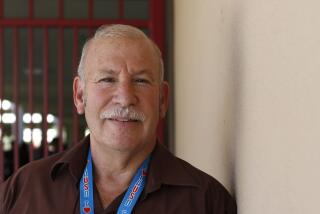L.A.’s shot at Race to the Top
Second chances don’t come around too often. Fourth chances? Almost never. But Los Angeles now has a remarkable opportunity to make up for California’s failures to win federal funds and to institute much-needed education reforms.
Three times in the last two years, California has competed in Race to the Top, the federal program that provides billions of dollars to states that promise to adopt bold education reforms. California has failed every round of the K-12 competition. Last year, the U.S. Department of Educationdismissed the state’s proposal as incomplete because Gov. Jerry Brown refused to sign it.
As a result, the Los Angeles Unified School District has gotten zero dollars from this program and implemented few of the reforms urged by President Obama and Education Secretary Arne Duncan. Meanwhile, only 43% of our students are proficient in math, and the 2010-11 school district report card shows that only 56% of students graduate from high school on time.
But this month, thanks in large part to Mayor Antonio Villaraigosa’s push for another approach, the White House gave L.A. another chance. Duncan announced that L.A. Unified, as well as other large school districts, can apply directly for Race to the Top funding rather than rely on their states’ applications. In other words, L.A. doesn’t have to get tangled up in the state’s mess when crafting its reform plan.
This is a precious opportunity. A winning application would accomplish two very important things. First, it would secure millions of dollars for a school district in the midst of a financial crisis so extreme that thousands of teachers may be laid off and essential programs and resources eliminated. Second, it would finally empower the district to implement desperately needed policy changes, particularly ones that ensure effective teaching in our classrooms.
L.A. Supt. John Deasy has touted precisely the reforms that Race to the Top judges are looking for in reviewing applications. Last summer, shortly after becoming superintendent, Deasy wrote an Op-Ed article for The Times detailing the changes he wants to bring to L.A. Unified. Now is the time for him to turn words into action.
Deasy called for a “robust and meaningful evaluation system” that provides teachers with the feedback they need to grow and excel. Such a system would consider multiple measures, including student test scores, classroom observations by trained evaluators, parent and student feedback and teachers’ contributions to their school communities. In the current system, a teacher’s evaluation is based on a single observation by the school principal, and 97% of teachers are rated “satisfactory.”
Deasy also urged a more sensible approach to granting tenure. Though state law requires that a tenure decision be made after two years, the superintendent has insisted on using thorough data and feedback to assess and support teachers as they approach the tenure mark. A higher bar for tenure should be accompanied by “a significant salary increase,” Deasy stated.
The superintendent has also come out strongly in favor of pay raises for teachers who demonstrate excellence in the classroom, particularly those who improve student achievement in low-performing schools. A better compensation system, after all, would likely entice strong teachers to remain at the schools where they are most needed.
These are the reforms Los Angeles needs. Not coincidentally, they are also the reforms found in winning Race to the Top applications from states such as Tennessee and Florida.
Anyone who has worked closely with Deasy, as I have both during my time on the school board and afterward, has no doubt that he is committed to making these changes a reality. He continues to work with teachers on a pilot evaluation system that could eventually spread throughout the district.
But Deasy can’t do it alone. The truth is that, given the history of Race to the Top winners, a successful application almost definitely will require solid agreement between the district and the teachers union.
That’s where United Teachers Los Angeles comes in. Historically, UTLA has been wary of, if not outright opposed to, any challenges to the status quo. However, in December, union leaders hashed out a bold new agreement with Deasy and district officials. Though that agreement left many urgent policy problems unresolved, it proves that the union and district leaders can work together to fix what is broken.
Now, with Duncan inviting L.A. to apply for federal funding, it’s time for both sides to pick up where last year’s agreement left off. This is a historic opportunity for the students of Los Angeles. It would be tragic if the adults squandered it.
Yolie Flores, the president and chief executive of Communities for Teaching Excellence, was a member of the LAUSD Board of Education from 2007 to 2011.
More to Read
A cure for the common opinion
Get thought-provoking perspectives with our weekly newsletter.
You may occasionally receive promotional content from the Los Angeles Times.






